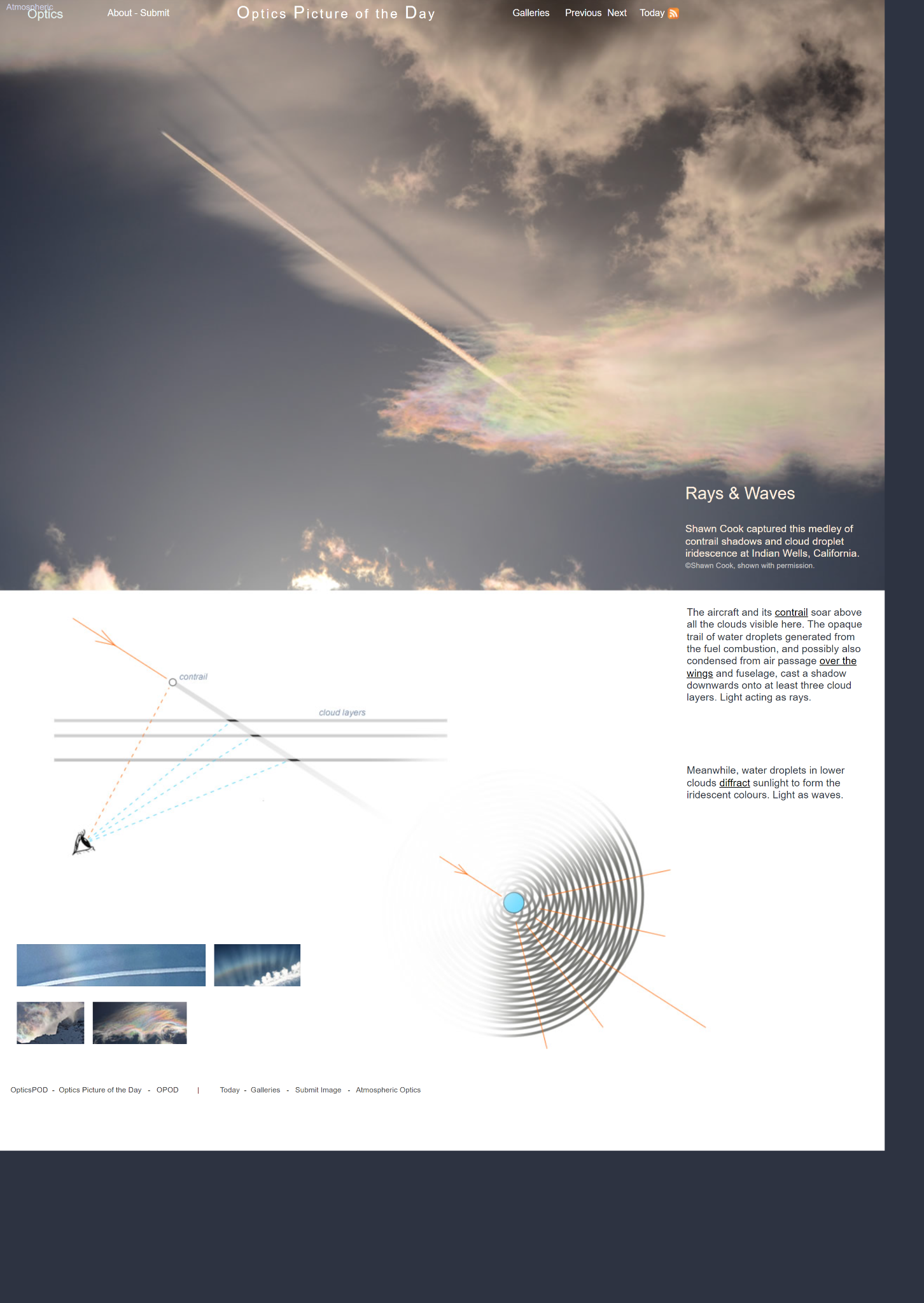OPOD - Rays & Waves
OPOD - Rays & Waves: A Captivating Atmospheric Display
Have you ever gazed up at the sky and marveled at the intricate patterns and colors that sometimes grace the heavens? Atmospheric optics is a fascinating field that explores the phenomena that occur when light interacts with particles in the atmosphere. One such captivating display is the interplay of rays and waves, as beautifully captured by photographer Shawn Cook in Indian Wells, California.
In Cook's mesmerizing photograph, we are treated to a medley of contrail shadows and cloud droplet iridescence. The contrail, a trail of water droplets formed from fuel combustion and possibly condensed from air passage over the aircraft's wings and fuselage, casts a shadow downwards onto multiple cloud layers. This shadow, created by the interaction of light as rays, adds depth and dimension to the sky.
Simultaneously, the lower clouds in the image exhibit a phenomenon known as iridescence. When sunlight encounters water droplets in these clouds, it diffracts and scatters, resulting in a stunning display of iridescent colors. This diffraction of light gives rise to the appearance of waves in the sky, adding a touch of ethereal beauty to the scene.
To understand this interplay between rays and waves in atmospheric optics, it is essential to delve deeper into the underlying principles at work. Here are some key points to consider:
-
Contrail Shadows: The contrail's shadow is formed when sunlight interacts with the dense concentration of water droplets in the contrail. As the light passes through these droplets, it is scattered in various directions, creating a shadow effect on the clouds below. This phenomenon is similar to how shadows are formed on the ground when sunlight passes through objects.
-
Cloud Droplet Iridescence: Iridescence occurs when sunlight interacts with tiny water droplets in clouds. As the sunlight passes through these droplets, it undergoes diffraction, causing the different colors of the spectrum to separate and become visible. The result is a captivating display of shimmering, iridescent hues.
-
Light as Rays: When light travels in a straight line, it behaves as rays. In the context of atmospheric optics, rays refer to the path that light takes as it interacts with various particles and objects in the atmosphere. The contrail shadow in Cook's photograph exemplifies this behavior, as the light is cast downward in a linear fashion, creating distinct shadows on the cloud layers.
-
Light as Waves: Light can also behave as waves, exhibiting properties such as diffraction and interference. In the case of cloud droplet iridescence, the diffraction of sunlight by water droplets causes the waves to separate and form the vibrant colors we observe. This wave-like behavior adds a dynamic and mesmerizing quality to the atmospheric display.
-
Atmospheric Interactions: The interplay between rays and waves in atmospheric optics is a result of the complex interactions between light and various atmospheric particles, including water droplets, ice crystals, and aerosols. These interactions can give rise to a multitude of optical phenomena, each with its own unique characteristics and beauty.
-
Observing Atmospheric Optics: Capturing the intricacies of atmospheric optics, such as the interplay of rays and waves, requires a keen eye and a passion for photography. Photographers like Shawn Cook are able to freeze these fleeting moments in time, allowing us to appreciate the hidden wonders that unfold above us every day.
In conclusion, the captivating display of rays and waves in atmospheric optics offers a glimpse into the enchanting world above. Through the interplay of contrail shadows and cloud droplet iridescence, we are reminded of the intricate beauty that exists within our atmosphere. So, next time you find yourself gazing up at the sky, take a moment to appreciate the mesmerizing dance of light and particles that unfolds before your eyes.

Rays & Waves
Shawn Cook captured this medley of contrail shadows and cloud droplet iridescence at Indian Wells, California. ©Shawn Cook, shown with permission.

The aircraft and its contrail soar above all the clouds visible here. The opaque trail of water droplets generated from the fuel combustion, and possibly also condensed from air passage over the wings and fuselage, cast a shadow downwards onto at least three cloud layers. Light acting as rays.
Meanwhile, water droplets in lower clouds diffract sunlight to form the iridescent colours. Light as waves.
Note: this article has been automatically converted from the old site and may not appear as intended. You can find the original article here.
Reference Atmospheric Optics
If you use any of the definitions, information, or data presented on Atmospheric Optics, please copy the link or reference below to properly credit us as the reference source. Thank you!
-
<a href="https://atoptics.co.uk/blog/opod-rays-waves/">OPOD - Rays & Waves</a>
-
"OPOD - Rays & Waves". Atmospheric Optics. Accessed on December 22, 2024. https://atoptics.co.uk/blog/opod-rays-waves/.
-
"OPOD - Rays & Waves". Atmospheric Optics, https://atoptics.co.uk/blog/opod-rays-waves/. Accessed 22 December, 2024
-
OPOD - Rays & Waves. Atmospheric Optics. Retrieved from https://atoptics.co.uk/blog/opod-rays-waves/.